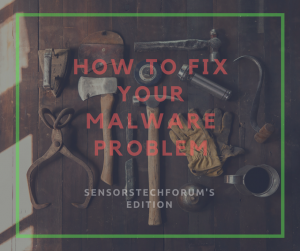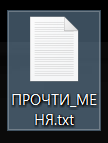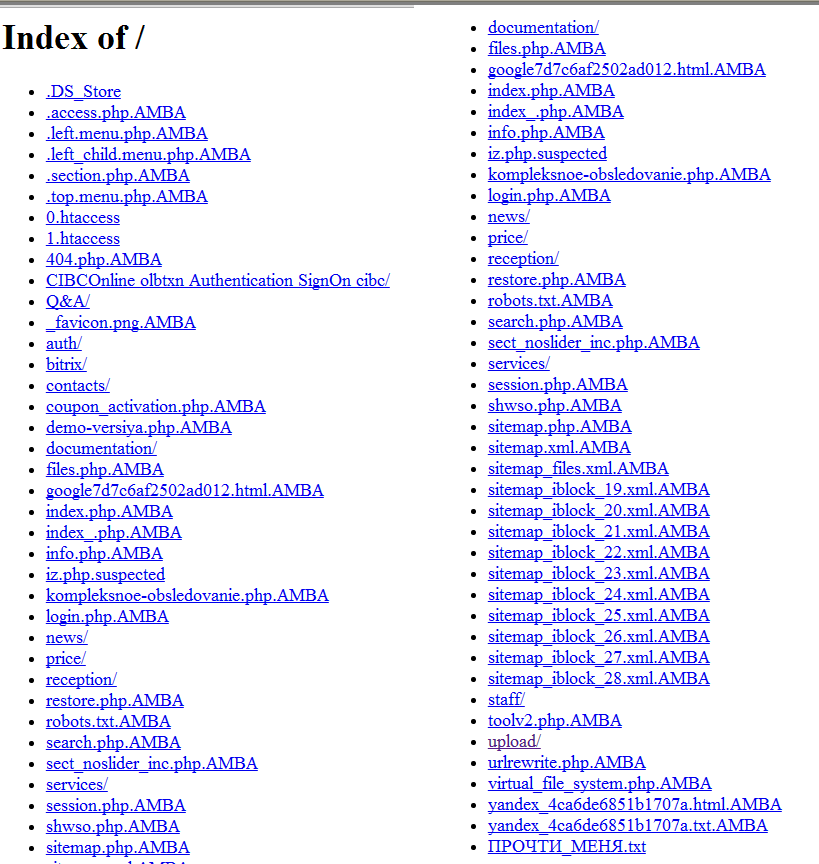 The AMBA virus, notorious for the fact that it encrypts the databases of websites with .amba file extension added to them has appeared on the radar. The crypto-virus directly attacks the “Index Of” belonging to websites whose servers are not properly secured. Its ransom note is written entirely in Russian language, and its variants have been reported to exist since the year 2013. All website publishers whose servers have been affected by the Amba ransomware are strongly advised to export the files and try to decrypt them instead of paying the requested ransom money.
The AMBA virus, notorious for the fact that it encrypts the databases of websites with .amba file extension added to them has appeared on the radar. The crypto-virus directly attacks the “Index Of” belonging to websites whose servers are not properly secured. Its ransom note is written entirely in Russian language, and its variants have been reported to exist since the year 2013. All website publishers whose servers have been affected by the Amba ransomware are strongly advised to export the files and try to decrypt them instead of paying the requested ransom money.

Threat Summary
| Name |
AMBA |
| Type | Ransomware |
| Short Description | Encrypts files of websites on infected servers and asks for ransom payoff for their decryption. |
| Symptoms | The user may witness a ransom note as a text document written in Russian, named “ПРОЧТИ_МЕНЯ.txt”. |
| Distribution Method | Via an Exploit kit, JavaScript or a Trojan. |
| Detection Tool |
See If Your System Has Been Affected by malware
Download
Malware Removal Tool
|
| User Experience | Join our forum to Discuss WildFire Ransomware. |
| Data Recovery Tool | Windows Data Recovery by Stellar Phoenix Notice! This product scans your drive sectors to recover lost files and it may not recover 100% of the encrypted files, but only few of them, depending on the situation and whether or not you have reformatted your drive. |

AMBA Ransomware’s Distribution Scheme
Since Amba ransomware attacks mostly servers, it may use different approach instead of the convention massive spam campaign. For example, if the server is located in a network with other devices, the virus may use a worm to spread across the network to other devices. In addition to this, the creators of Amba may also send malicious URLs directly on the website as spam comments. Such web links may redirect to other URLs which may cause the infection via a drive-by-download. Another possibility is a targeted attack with a Trojan.Downloader, which can download AMBA ransomware’s malicious files, directly on the server.

AMBA Ransomware Viewed In Depth
As soon as it is executed on a given machine, AMBA begins to encipher files that are web server related, for example they may have the following extensions:
→ .4UI .ADB .AFP .ANH .ANTMPL .AO .AP .ARTICLE .AVERY .BCF .BCP .BIZ .BLK .BOOK .BPF .BRO .BRO .BTW .CADOC .CAJ .CAL .CBF .CD2 .CDF .CDML .CDOC .CEDPRJ .CH3 .CL2ARC .CL2DOC .CL2LYT .CL2TPL .CLD .CLKB .CLKBD .CLKC .CLKD .CLT .CNDX .COMICDOC .COMICLIFE .COMPOSITIONTEMPLATE .COV .CPE .CPH .CPY .CRTR .CSD .CST .CVW .CW .CWT .DCX .DMTEMPLATE .DOT .DPD .DRMX .DRMZ .DTL .DTP .DTX .DWDOC .EDRWX .ENC .ENV .FADEIN .FAX .FCDT .FD2 .FDD .FDT .FLB .FM .FOLIO .FORM .FP3 .FR3 .FRDOC .FRF .FSD .FXM .GEM .HCR .HFD .HFT .HMK .HPD .HPT .ICAP .ICML .ICMT .IDAP .IDML .IDMS .IDPK .IFD .ILDOC .IMM .IMTX .IMX .INCD .INCT .INCX .IND .INDB .INDD .INDL .INDP .INDS .INDT .INFOPATHXML .INP .INX .ISALE .ISALETEMPLATE .ISALLIC .ISD .JTP .JTX .JTX .LAB .LBL .LBL .LLD .LMA .LPDF .LSC .LST .LTF .MAILSTATIONERY .MARS .MAX .MBBK .MCSP .MCSX .MDI .MFO .MFP .MFT .MGA .MIF
After encrypting the databases of websites, the AMBA virus adds its own “trademark” – the AMBA file extension. Files of websites encrypted by AMBA look like the following image, reported by Amigo A – malware researcher at id-ransomware.blogspot.bg:
After encrypting the files on the website of the server, AMBA ransomware uses a text file to notify users that their files have been encrypted. The file is named ПРОЧТИ_МЕНЯ.txt and has the following message in it:
Место для Вашей рекламы
——————————————————————————–
Вся Ваша информация (документы, базы данных, бэкапы)
на этом компьютере была зашифрована.
Для расшифровки обратитесь по нижеуказанным контактам.

Ни в коем случае не изменяйте файлы!
И не используйте чужие дешифраторы, Вы можете потерять Ваши файлы навсегда.
Каждый дешифратор – уникален, чужой – просто испортит Ваши файлы.
Благодоря нам – вы можете усилить свою безопасность
и предотвратить подобные ситуации!
——————————————————————————–
e-mail: amba@riseup.net
———————————–
Ваш код для разблокировки: {UNIQUE VICTIM ID}
—————————————————————
Внимание! В первом письме не прикрепляйте файлы для дешифровки.
Все инструкции вы получите в ответном письме.”
The ransom message translates to the following:
All your information (documents, database files, backups) on this computer was encrypted. To decrypt it contact the belowmentioned contacts. Do not try to modify the files in any circumstance! Do not use foreign decryptors, you may lose your files forever. Every decrypter – unique, foreign will just break your files. Thanks to us, you can increase your safety and avoid such situations!
e-mail: amba@riseup.net
Your decipher code: {UNIQUE VICTIM ID}
Attention! In the first letter do not attach the decipher code. Your will receive all instructions in the reply letter”

Remove AMBA Ransomware from Your Server
To get rid of AMBA ransomware, we strongly advise you to make sure to isolate the threat first. We have prepared a removal on how to get in safe mode and hopefully stop any processes which belong to AMBA Ransomware. You may also want to restore your files, for which there is no current decryptor. We have prepared instructions below which will help you to remove AMBA ransomware effectively from Windows servers and try to restore your files.
If you want to use the manual removal instructions, we advise you to look for it in the system folders of your server. In case you cannot find them and find any registry entries associated with AMBA, we advise you to follow the automatic removal instructions which are also recommended by experts. They include instructions on how to try alternative methods to get your files back.
- Step 1
- Step 2
- Step 3
- Step 4
- Step 5
Step 1: Scan for AMBA with SpyHunter Anti-Malware Tool



Ransomware Automatic Removal - Video Guide
Step 2: Uninstall AMBA and related malware from Windows
Here is a method in few easy steps that should be able to uninstall most programs. No matter if you are using Windows 10, 8, 7, Vista or XP, those steps will get the job done. Dragging the program or its folder to the recycle bin can be a very bad decision. If you do that, bits and pieces of the program are left behind, and that can lead to unstable work of your PC, errors with the file type associations and other unpleasant activities. The proper way to get a program off your computer is to Uninstall it. To do that:


 Follow the instructions above and you will successfully delete most unwanted and malicious programs.
Follow the instructions above and you will successfully delete most unwanted and malicious programs.
Step 3: Clean any registries, created by AMBA on your computer.
The usually targeted registries of Windows machines are the following:
- HKEY_LOCAL_MACHINE\Software\Microsoft\Windows\CurrentVersion\Run
- HKEY_CURRENT_USER\Software\Microsoft\Windows\CurrentVersion\Run
- HKEY_LOCAL_MACHINE\Software\Microsoft\Windows\CurrentVersion\RunOnce
- HKEY_CURRENT_USER\Software\Microsoft\Windows\CurrentVersion\RunOnce
You can access them by opening the Windows registry editor and deleting any values, created by AMBA there. This can happen by following the steps underneath:


 Tip: To find a virus-created value, you can right-click on it and click "Modify" to see which file it is set to run. If this is the virus file location, remove the value.
Tip: To find a virus-created value, you can right-click on it and click "Modify" to see which file it is set to run. If this is the virus file location, remove the value.
Before starting "Step 4", please boot back into Normal mode, in case you are currently in Safe Mode.
This will enable you to install and use SpyHunter 5 successfully.
Step 4: Boot Your PC In Safe Mode to isolate and remove AMBA





Step 5: Try to Restore Files Encrypted by AMBA.
Method 1: Use STOP Decrypter by Emsisoft.
Not all variants of this ransomware can be decrypted for free, but we have added the decryptor used by researchers that is often updated with the variants which become eventually decrypted. You can try and decrypt your files using the instructions below, but if they do not work, then unfortunately your variant of the ransomware virus is not decryptable.
Follow the instructions below to use the Emsisoft decrypter and decrypt your files for free. You can download the Emsisoft decryption tool linked here and then follow the steps provided below:
1 Right-click on the decrypter and click on Run as Administrator as shown below:

2. Agree with the license terms:

3. Click on "Add Folder" and then add the folders where you want files decrypted as shown underneath:

4. Click on "Decrypt" and wait for your files to be decoded.

Note: Credit for the decryptor goes to Emsisoft researchers who have made the breakthrough with this virus.
Method 2: Use data recovery software
Ransomware infections and AMBA aim to encrypt your files using an encryption algorithm which may be very difficult to decrypt. This is why we have suggested a data recovery method that may help you go around direct decryption and try to restore your files. Bear in mind that this method may not be 100% effective but may also help you a little or a lot in different situations.
Simply click on the link and on the website menus on the top, choose Data Recovery - Data Recovery Wizard for Windows or Mac (depending on your OS), and then download and run the tool.
AMBA-FAQ
What is AMBA Ransomware?
AMBA is a ransomware infection - the malicious software that enters your computer silently and blocks either access to the computer itself or encrypt your files.
Many ransomware viruses use sophisticated encryption algorithms to make your files inaccessible. The goal of ransomware infections is to demand that you pay a ransom payment to get access to your files back.
What Does AMBA Ransomware Do?
Ransomware in general is a malicious software that is designed to block access to your computer or files until a ransom is paid.
Ransomware viruses can also damage your system, corrupt data and delete files, resulting in the permanent loss of important files.
How Does AMBA Infect?
Via several ways.AMBA Ransomware infects computers by being sent via phishing emails, containing virus attachment. This attachment is usually masked as an important document, like an invoice, bank document or even a plane ticket and it looks very convincing to users.
Another way you may become a victim of AMBA is if you download a fake installer, crack or patch from a low reputation website or if you click on a virus link. Many users report getting a ransomware infection by downloading torrents.
How to Open .AMBA files?
You can't without a decryptor. At this point, the .AMBA files are encrypted. You can only open them once they are decrypted using a specific decryption key for the particular algorithm.
What to Do If a Decryptor Does Not Work?
Do not panic, and backup the files. If a decryptor did not decrypt your .AMBA files successfully, then do not despair, because this virus is still new.
Can I Restore ".AMBA" Files?
Yes, sometimes files can be restored. We have suggested several file recovery methods that could work if you want to restore .AMBA files.
These methods are in no way 100% guaranteed that you will be able to get your files back. But if you have a backup, your chances of success are much greater.
How To Get Rid of AMBA Virus?
The safest way and the most efficient one for the removal of this ransomware infection is the use a professional anti-malware program.
It will scan for and locate AMBA ransomware and then remove it without causing any additional harm to your important .AMBA files.
Can I Report Ransomware to Authorities?
In case your computer got infected with a ransomware infection, you can report it to the local Police departments. It can help authorities worldwide track and determine the perpetrators behind the virus that has infected your computer.
Below, we have prepared a list with government websites, where you can file a report in case you are a victim of a cybercrime:
Cyber-security authorities, responsible for handling ransomware attack reports in different regions all over the world:
Germany - Offizielles Portal der deutschen Polizei
United States - IC3 Internet Crime Complaint Centre
United Kingdom - Action Fraud Police
France - Ministère de l'Intérieur
Italy - Polizia Di Stato
Spain - Policía Nacional
Netherlands - Politie
Poland - Policja
Portugal - Polícia Judiciária
Greece - Cyber Crime Unit (Hellenic Police)
India - Mumbai Police - CyberCrime Investigation Cell
Australia - Australian High Tech Crime Center
Reports may be responded to in different timeframes, depending on your local authorities.
Can You Stop Ransomware from Encrypting Your Files?
Yes, you can prevent ransomware. The best way to do this is to ensure your computer system is updated with the latest security patches, use a reputable anti-malware program and firewall, backup your important files frequently, and avoid clicking on malicious links or downloading unknown files.
Can AMBA Ransomware Steal Your Data?
Yes, in most cases ransomware will steal your information. It is a form of malware that steals data from a user's computer, encrypts it, and then demands a ransom in order to decrypt it.
In many cases, the malware authors or attackers will threaten to delete the data or publish it online unless the ransom is paid.
Can Ransomware Infect WiFi?
Yes, ransomware can infect WiFi networks, as malicious actors can use it to gain control of the network, steal confidential data, and lock out users. If a ransomware attack is successful, it could lead to a loss of service and/or data, and in some cases, financial losses.
Should I Pay Ransomware?
No, you should not pay ransomware extortionists. Paying them only encourages criminals and does not guarantee that the files or data will be restored. The better approach is to have a secure backup of important data and be vigilant about security in the first place.
What Happens If I Don't Pay Ransom?
If you don't pay the ransom, the hackers may still have access to your computer, data, or files and may continue to threaten to expose or delete them, or even use them to commit cybercrimes. In some cases, they may even continue to demand additional ransom payments.
Can a Ransomware Attack Be Detected?
Yes, ransomware can be detected. Anti-malware software and other advanced security tools can detect ransomware and alert the user when it is present on a machine.
It is important to stay up-to-date on the latest security measures and to keep security software updated to ensure ransomware can be detected and prevented.
Do Ransomware Criminals Get Caught?
Yes, ransomware criminals do get caught. Law enforcement agencies, such as the FBI, Interpol and others have been successful in tracking down and prosecuting ransomware criminals in the US and other countries. As ransomware threats continue to increase, so does the enforcement activity.
About the AMBA Research
The content we publish on SensorsTechForum.com, this AMBA how-to removal guide included, is the outcome of extensive research, hard work and our team’s devotion to help you remove the specific malware and restore your encrypted files.
How did we conduct the research on this ransomware?
Our research is based on an independent investigation. We are in contact with independent security researchers, and as such, we receive daily updates on the latest malware and ransomware definitions.
Furthermore, the research behind the AMBA ransomware threat is backed with VirusTotal and the NoMoreRansom project.
To better understand the ransomware threat, please refer to the following articles which provide knowledgeable details.
As a site that has been dedicated to providing free removal instructions for ransomware and malware since 2014, SensorsTechForum’s recommendation is to only pay attention to trustworthy sources.
How to recognize trustworthy sources:
- Always check "About Us" web page.
- Profile of the content creator.
- Make sure that real people are behind the site and not fake names and profiles.
- Verify Facebook, LinkedIn and Twitter personal profiles.














